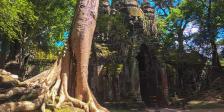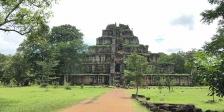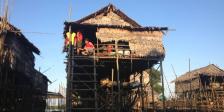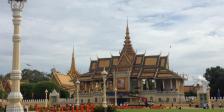Rather than a hill range, Phnom Kulen is an isolated chain of small mountain plateaux of moderate height lying south of the Dângrêk Mountains. The range stretches for about 49 km in a WNW - ESE direction and is located some 65 km north of Siem Reap.
Its highest point is 487 m and its height is quite regular, averaging 400 m all along the range. Geologically Phnom Kulen is formed of sandstone. It was important as a quarry in Angkorian times, the major quarries being located in the southeastern angle of the massif.
There is a sanctuary in the area, Phnom Kulen National Park. Its purpose is recreational and scientific in order to preserve the natural scenic features of Phnom Kulen mountain, like some famous waterfalls.
is located 30 km northwards from Angkor Wat. Its name means "mountain of the lychees".[3] There is a sacred hilltop site on top of the range.
Phnom Kulen is considered a holy mountain in Cambodia, of special religious significance to Hindus and Buddhists who come to the mountain in pilgrimage.
It also has a major symbolic importance for Cambodians as the birthplace of the ancient Khmer Empire, for it was at Phnom Kulen that King Jayavarma II proclaimed independence from Java in 804 CE. Jayavarman II initiated the cult of the king, a linga cult, in what is dated as 804 CE and declaring his independence from Java of whom the Khmer had been a vassalage state (whether this is actually "Java" or "Lava" (a Lao kingdom) is debated, as well as the legend that he was earlier held as a ransom of the kingdom in Java. See Higham's The Civilization of Angkor for more information about the debate). During the Angkorian era the relief was known as Mahendraparvata (the mountain of Great Indra).
The site is known for its carvings representing fertility and its waters which hold special significance to Hindus. Just 5 cm under the water's surface over 1000 small carvings are etched into the sandstone riverbed. The waters are regarded as holy, given that Jayavarman II chose to bathe in the river, and had the river diverted so that the stone bed could be carved. Carvings include a stone representation of the Hindu god Vishnu lying on his serpent Ananta, with his wife Lakshmi at his feet. A lotus flower protrudes from his navel bearing the god Brahma. The river then ends with a waterfall and a pool.
Near these mountains is Preah Ang Thom, a 16th-century Buddhist monastery notable for the giant reclining Buddha, the country's largest.[6]
The Samré tribe was formerly living at the edge of Phnom Kulen, quarrying sandstone and transporting it to the royal sit.


 Hot Line: +855 88 7272 445
Hot Line: +855 88 7272 445










.jpg)

